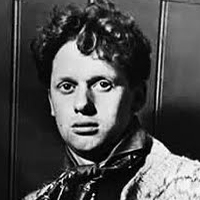The Force That Through the Green Fuse Drives the Flower by Dylan Thomas: Summary and Analysis
Dylan Thomas is a Welsh Poet who composed this poem in 1933 and published for the first time in the collection 18 Poems in 1934. The celebration of single force operative in the nature and man, living and dead has made the poet neo-romantic. He regards nature as the living organism of which we are the parts.

Dylan Thomas (1914-1953)
In the surface reading of the poem, the speaker is making a comparison between the human world and the world of the nature and between the living and dead (man and nature and living and dead). In the opening of the poem, the speaker connects human being with the nature. The speaker argues that the force that works in the human body works in the world of the nature. So, whatever force destroy the mankind the same force destroys the nature. What gives us youth the same force gives youth to the nature and the same force takes youth from both mankind and the nature. In this sense, we are one that the same force is responsible for the birth and decay in man and in nature.
The speaker is shocked with the revelation of the fact that the rose and the mankind share the same fate and said ‘And I am dumb’. He brings parallel comparison between the water that runs through the stem of the plants and the blood that runs through the veins of the mankind. The one ultimate force can change the blood into wax and again the theme of birth and death is repeated here by the speaker. The powerful imagery like water, rock, mountain streams and springs, blood, wax, veins and mouth are very cleverly used here.
Besides nature and human, the poem concerns with dead and living. What decomposes the body of the dead, the same force decomposes the body of the living. Both living and the dead are the subjected to the same force of the nature. The speaker agrees that the same hand is bringing quicksand and whirlpool in the nature and the decay or death in the mankind.
The speaker is now clear that the creation and destruction are the two sides of the time. Time gives pain, it nourishes, and heals too. The leech in poem sucks its fountain or the source just as the baby who is born causes bleeding to the mother. At the birth, though the mother bleeds and causes severe pain, it soothes her because of the life she has given birth. The birth is again the subject to the death.
He concludes that no one can escape this cycle by showing the worm digging his sheet of paper which also digs the dead body in the grave. He is convinced that though he is far from the death, its appearance is always near him in one or another form. In this regard, the celebration of the ultimate force turns out to be the appreciation of the nature.
This poem is a rich in imagery that connects human being and nature to the one mighty force and the process of birth and death. Though the poem is short, it is highly compressed. It had four stanzas five lines with and a final couplet.
The repetition of the refrain ‘And I am dumb’ strongly suggest the idea of the speaker being so amazed and surprised with the knowledge that the same force is at work in the nature and in the mankind. In this regard, mankind and the nature are tiny parts of same universal Nature.
The poem caters some important themes of: cycle of life, balance and interconnectedness. The theme of the cycle of life is prevalent throughout the poem. The birth and the death imagery are rich in the poem. The force that creates the flower, baby, springs and life of the mankind is also responsible for the death and destruction. The same force causes a flower to bloom and the exact force ‘blasts the roots’ of the trees. The birth and creation of any new object are the subject to death, the cycle of life and death continues in one or another form. The theme of balance is seen in the use of imagery and in the structure of the poem. The first two stanzas are balanced, providing with the two opposite process in nature and in man. The use of the semicolon in each second line of first and second stanzas shows the balance of two different aspects of the same force: one indicating birth and the second indicating death.
Another important theme of interconnectedness is also dominant in the poem. The fate of beautiful flower and the fate of the human being is same. The smallest of the creatures and the huge mountains too are the subject of the same force that bring change either in the form birth or in the form of death. The pattern of change of birth and death is universal, so all the microorganism and macro organism are connected to each other.
